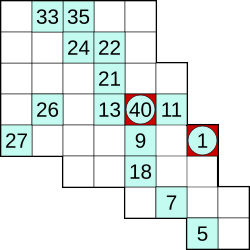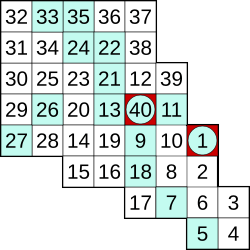Hidato facts for kids
Hidato is a fun logic puzzle game. It was created by an Israeli mathematician named Dr. Gyora M. Benedek. You might also hear it called "Hidoku." The word "Hidato" comes from a Hebrew word meaning "riddle."
In this game, your goal is to fill a grid with consecutive numbers that follow each other in order. These numbers must connect to each other up, down, or even diagonally. Some other names for this puzzle are Number Snake, Snakepit, Jadium, or Numbrix.
What is Hidato?
In Hidato, you get a grid of cells. It's usually square-shaped, like Sudoku or Kakuro. But it can also have other shapes, like hexagons, as long as they fit together perfectly. The grid might even have holes in the middle, but it always stays as one connected piece.
The main goal is to fill every cell in the grid with numbers that go in order, one after another. For example, if you have the number 5, the number 6 must be right next to it. These numbers can connect horizontally (sideways), vertically (up and down), or diagonally (corner to corner).
Every Hidato puzzle already has the smallest and the largest numbers placed in the grid. It also has a few other numbers scattered around. These numbers help you figure out where to start and make sure there's only one correct way to solve the puzzle.
A good Hidato puzzle should have only one solution. Puzzles made for people to solve should be solvable using logical thinking. However, some Hidato puzzles can be very tricky, even if they are small!
Where can you find Hidato?
After Hidato became popular, other similar puzzles appeared. One example is Numbrix, created by Marilyn vos Savant. These puzzles are like Hidato, but you can only connect numbers horizontally or vertically, not diagonally. Also, Numbrix puzzles are always square, usually 7x7 or 9x9 grids.
Another puzzle called Jadium (which used to be called Snakepit) is a harder version of Numbrix. It has fewer starting numbers, making it more challenging. Jadium puzzles have been available online since 2014.
How to solve Hidato puzzles
Solving Hidato is a lot like solving other logic puzzles. A basic way to start is to look at each empty cell and think about which numbers could possibly go there.
- If a cell can only hold one specific number, then you know that's the correct number for that spot. This is like finding a "Naked Single."
- If a number has only one possible place it can go in the entire grid, then you can put it there. This is like finding a "Hidden Single."
A helpful tip is that you don't have to fill the numbers in order from smallest to largest. You can start from any of the given numbers and build parts of the solution. For example, you might fill in numbers going up from one given number and numbers going down from another.
For harder Hidato or Numbrix puzzles, you might need to use more advanced techniques. These often involve looking for patterns or chains of possibilities to figure out the correct numbers.
See also
 In Spanish: Hidato para niños
In Spanish: Hidato para niños



